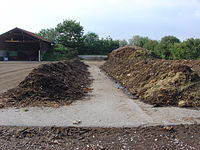
Photo from wikipedia
Denitrifying woodchip bioreactors are a practical nitrogen (N) mitigation technology but evaluating the potential for bioreactor phosphorus (P) removal is highly relevant given that (1) agricultural runoff often contains N… Click to show full abstract
Denitrifying woodchip bioreactors are a practical nitrogen (N) mitigation technology but evaluating the potential for bioreactor phosphorus (P) removal is highly relevant given that (1) agricultural runoff often contains N and P, (2) very low P concentrations cause eutrophication, and (3) there are few options for removing dissolved P once it is in runoff. A series of batch tests evaluated P removal by woodchips that naturally contained a range of metals known to sorb P and then three design and environmental factors (water matrix, particle size, initial dissolved reactive phosphorus (DRP) concentration). Woodchips with the highest aluminum and iron content provided the most dissolved P removal (13±2.5 mg DRP removed/kg woodchip). However, poplar woodchips, which had low metals content, provided the second highest removal (12±0.4 mg/kg) when they were tested with P-dosed river water which had a relatively complex water matrix. Chemical P sorption due to woodchip elements may be possible, but it is likely one of a variety of P removal mechanisms in real-world bioreactor settings. Scaling the results indicated bioreactors could remove 0.40 to 13 g DRP/ha. Woodchip bioreactor dissolved P removal will likely be small in magnitude, but any such contribution is an added-value benefit of this denitrifying technology.
Journal Title: Environmental Science and Pollution Research
Year Published: 2021
Link to full text (if available)
Share on Social Media: Sign Up to like & get
recommendations!